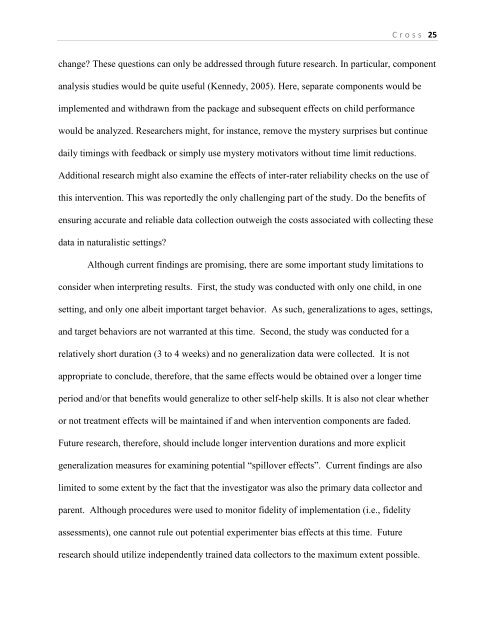THE EFFECTS OF A TIMER AND MYSTERY MOTIVATORS ON THE ...
THE EFFECTS OF A TIMER AND MYSTERY MOTIVATORS ON THE ...
THE EFFECTS OF A TIMER AND MYSTERY MOTIVATORS ON THE ...
You also want an ePaper? Increase the reach of your titles
YUMPU automatically turns print PDFs into web optimized ePapers that Google loves.
C r o s s 25<br />
change? These questions can only be addressed through future research. In particular, component<br />
analysis studies would be quite useful (Kennedy, 2005). Here, separate components would be<br />
implemented and withdrawn from the package and subsequent effects on child performance<br />
would be analyzed. Researchers might, for instance, remove the mystery surprises but continue<br />
daily timings with feedback or simply use mystery motivators without time limit reductions.<br />
Additional research might also examine the effects of inter-rater reliability checks on the use of<br />
this intervention. This was reportedly the only challenging part of the study. Do the benefits of<br />
ensuring accurate and reliable data collection outweigh the costs associated with collecting these<br />
data in naturalistic settings?<br />
Although current findings are promising, there are some important study limitations to<br />
consider when interpreting results. First, the study was conducted with only one child, in one<br />
setting, and only one albeit important target behavior. As such, generalizations to ages, settings,<br />
and target behaviors are not warranted at this time. Second, the study was conducted for a<br />
relatively short duration (3 to 4 weeks) and no generalization data were collected. It is not<br />
appropriate to conclude, therefore, that the same effects would be obtained over a longer time<br />
period and/or that benefits would generalize to other self-help skills. It is also not clear whether<br />
or not treatment effects will be maintained if and when intervention components are faded.<br />
Future research, therefore, should include longer intervention durations and more explicit<br />
generalization measures for examining potential “spillover effects”. Current findings are also<br />
limited to some extent by the fact that the investigator was also the primary data collector and<br />
parent. Although procedures were used to monitor fidelity of implementation (i.e., fidelity<br />
assessments), one cannot rule out potential experimenter bias effects at this time. Future<br />
research should utilize independently trained data collectors to the maximum extent possible.
















